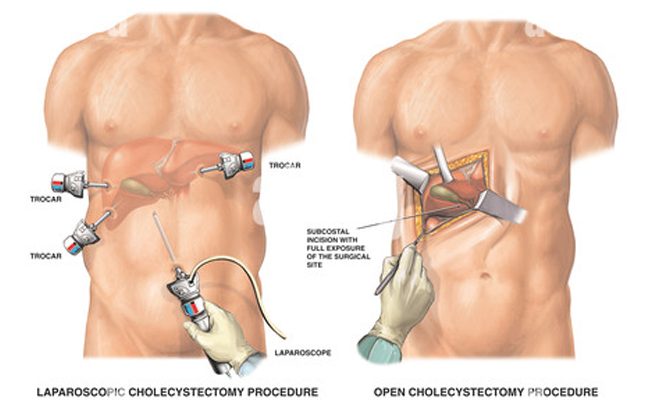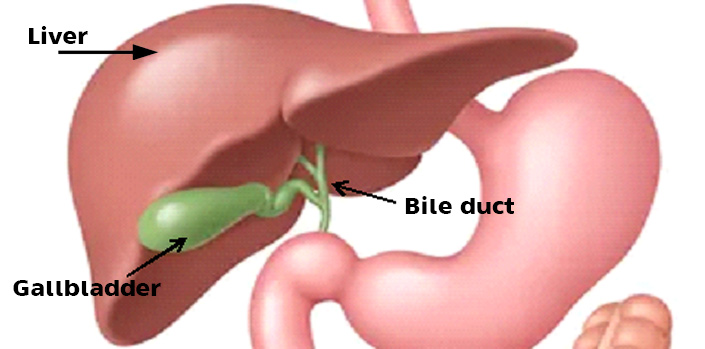Laparoscopic Cholecystectomy
What is laparoscopic surgery?
Laparoscopic surgery is also called as Minimally invasive surgery or Key hole surgery, where in surgeon access the abdomen and pelvis through small incisions of 1cms size and inserts camera and instruments through those small incisions, avoiding large incisions on the skin.

What is a laparoscopic cholecystectomy?
A laparoscopic cholecystectomy is surgery to remove your gallbladder.
The surgeon makes a few small incisions on the right side of your abdomen (belly). The surgeon uses one incision to insert a laparoscope, a thin tube with a camera on the end. This shows your gallbladder on a screen. The gallbladder then gets removed through another small incision.
A laparoscopic cholecystectomy is less invasive than an open cholecystectomy. Gall bladder removal by open method involves a larger incision.

What is the gallbladder?
Gallbladder is a pear shaped small organ located at under surface of the liver. It stores and concentrates the bile, secreted by liver. It releases the bile when food reaches the duodenum. Bile helps in digesting the fatty foods.

Who needs to have gallbladder removal?
People with gallstones (stones of gallbladder) having pain and infection will require this surgery.
Gallstones are crystals that form in the gallbladder. They can block the flow of bile out of the gallbladder into your digestive system. This roadblock causes pain in upper part of abdomen and sometimes causes infection i.e cholecystitis (inflammation of the gallbladder). Gallstones can also move out of gallbladder to bile duct and cause problems like jaundice, fever, pancreatitis etc.
Symptoms of gallstones include:
- Pain in the right side of the abdomen, which may reach the back or the shoulder.
- Feeling bloated.
- Fever.
- Jaundice (yellow-looking skin).
- Nausea.
How to detect the gallstones?
Gallstones are detected by doing ultrasonography (USG) scan of the abdomen. Which detects the presence of gallstones and its complications.
PROCEDURE DETAILS
What happens during laparoscopic cholecystectomy?
Laparoscopic cholecystectomy takes about an hour or two. A surgeon will make a few small incisions in your abdomen. The surgeon will insert thin, hollow tubes into those incisions. The surgical team will then place a laparoscope and other surgical tools into the tubes.
Your team may pump carbon dioxide into your abdomen. This step inflates the surgical area and makes it easier to see inside. Using the special tools, the surgeon will detach the gallbladder from the rest of the body and remove it. The team will then close the incisions with stitches, surgical clips or surgical glue.
If any complications occur during laparoscopic cholecystectomy, the surgeon may decide to use an open cholecystectomy instead. That procedure involves a larger incision.
What happens after laparoscopic cholecystectomy?
Your team will watch you for a few hours after surgery. They want to make sure you wake up from the anesthesia without complications. They will check your heart, breathing, blood pressure and ability to urinate (pee).
RISKS / BENEFITS
What are the benefits of gallbladder removal?
Removing the gallbladder will stop the pain and treat the infection caused by gallstones. It can also stop gallstones from coming back.
If gallstones are not treated, pain and infection can get worse. The gallbladder may burst, which can be life-threatening.
What are the benefits of laparoscopic cholecystectomy?
Your healthcare provider or surgeon will determine whether open or laparoscopic cholecystectomy is right for you. The laparoscopic procedure has several benefits:
- Less pain.
- Lower risk of complications.
- Quicker recovery and return to regular activities.
- Smaller wounds and scars.
What are the risks or possible complications of laparoscopic cholecystectomy?
Like any surgery, laparoscopic cholecystectomy has some risks, but they are rare:
- Bile leaking in the body.
- Bleeding.
- Complications from anesthesia.
- Hernia.
- Injury to the bile ducts, liver or intestines.
- Numbness in the surgical area.
- Peritonitis (inflammation and infection in the abdomen).
- Small scars from the incisions.
- Urinary tract infection.
RECOVERY AND OUTLOOK
What is the recovery time after laparoscopic cholecystectomy?
If you don’t have any complications, you can usually go home the next day of your laparoscopic cholecystectomy. With an open cholecystectomy, you may have to stay in the hospital for two or more days.
What should I do to take care of myself after gallbladder removal?
After surgery, do the following to help yourself recover:
- Avoid lifting heavy things.
- Drink plenty of water.
- Eat foods high in fiber to help your bowel movements (pooping).
- Follow your healthcare provider’s instructions about taking care of your wounds and taking medications.
- Slowly increase your activity.
- Walk a little bit every day to prevent blood clots.
When can I go back to normal activities after laparoscopic cholecystectomy?
Without complications, you should be able to drive and eat normally in a day or two. You usually can return to work and other daily activities in about a week, as long as they don’t involve lifting. You may need a week or two before you are physically or sexually active.
WHEN TO CALL THE DOCTOR
When should I seek medical attention after gallbladder removal?
After you go home, call your healthcare provider right away if you develop any of the following:
- Chills.
- Cramps in your abdomen or severe pain.
- High fever (over 101 degrees Fahrenheit).
- Incision problems, like bleeding, swelling, redness or a funny smell.
- No bowel movement for three days.
- Vomiting.
- Yellow skin or jaundice
A note from Dr. Lokesh HM
Gallstones can be very painful and dangerous. Laparoscopic cholecystectomy removes the gallbladder and prevents gallstones from coming back. Most people fully recover from the minimally invasive procedure in just a few weeks. But call your healthcare provider if you experience any problems after surgery.
